Some links on this page are affiliate links. This means we may earn a commission at no additional cost to you if you click through and make a purchase, you can check our Affiliate Disclosure. Thank you for your support!
What Makes an Ideal Kitchen? The kitchen is an important part of our daily lives and is often called the “heart of the home.” It is not just a place to cook and prepare food; it’s also a place where family gets together, friends hang out, and memories are made. An ideal kitchen goes beyond the limits of what is functional and what is aesthetically pleasing. It has the right amount of comfort, efficiency, and style.
It is essential to understand how important a good kitchen is because it can significantly affect our lives. Having a well-designed ideal kitchen not only makes cooking more fun but also improves the health of the whole family. A welcoming atmosphere, well-placed appliances, and storage space are all essential parts of a smooth cooking experience that lowers stress and boosts productivity.
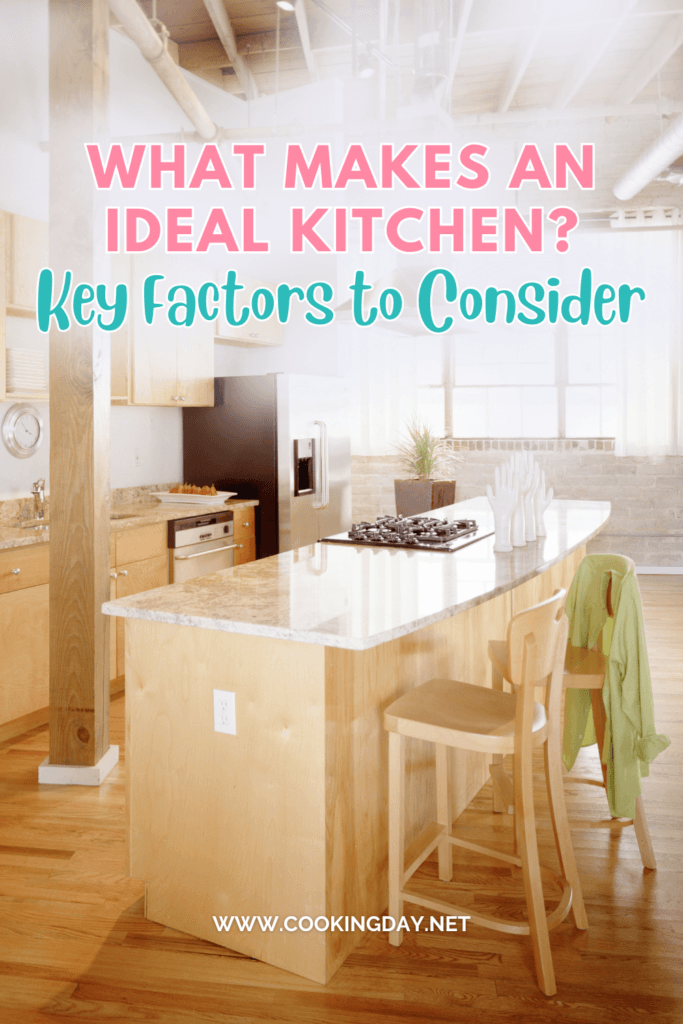
An ideal kitchen is also essential in making a house more valuable. When people are looking to buy a home, they often put a lot of weight on the condition and design of the kitchen because they know it affects their daily lives and the overall look of the house. So, a modern ideal kitchen that looks good, works well, and is functional can be a significant investment that pays off in the long run in terms of property value.
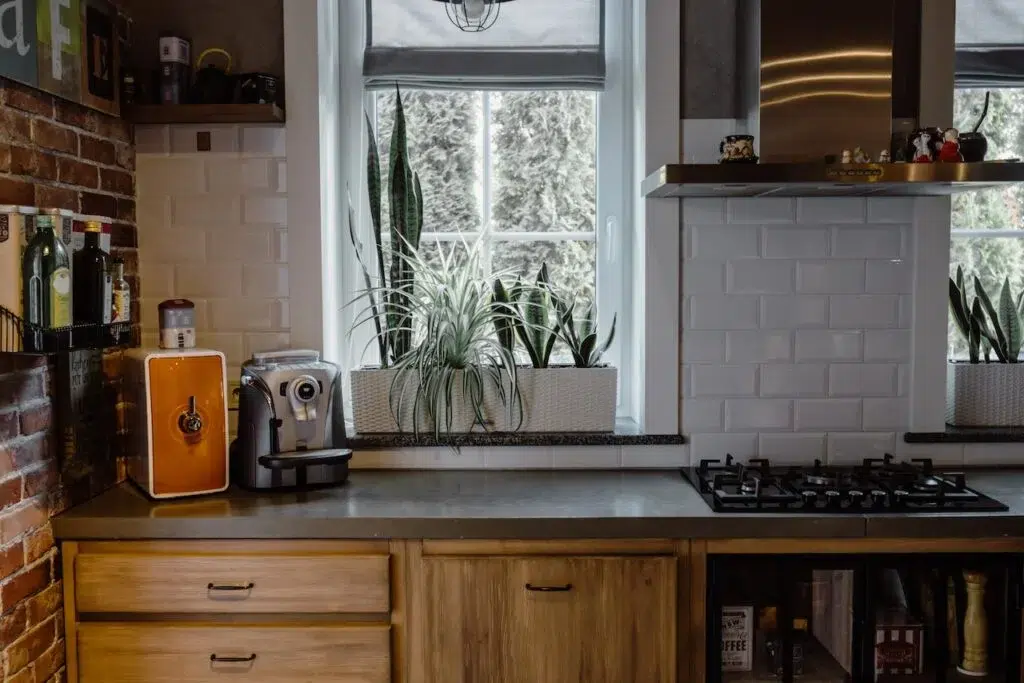
As we go through this complete guide, we will look at the most important things that go into making a great kitchen. We want to help you make your ideal kitchen a place that fits your needs, shows off your style, and improves your life by giving you helpful information and tips on everything from layout and design to appliances, storage, and personal touches. Whether you want to remodel your kitchen or start from scratch and design a new one, this guide will give you the information and ideas you need to make your dream kitchen.
The Essential Components of an Ideal Kitchen
Creating an ideal kitchen is a holistic process that encompasses various elements. Each component is crucial in ensuring the space is functional, aesthetically pleasing, and tailored to the users’ needs. Here’s a closer look at the essential elements that contribute to the perfection of a kitchen:
Efficient Layout and Space Utilization
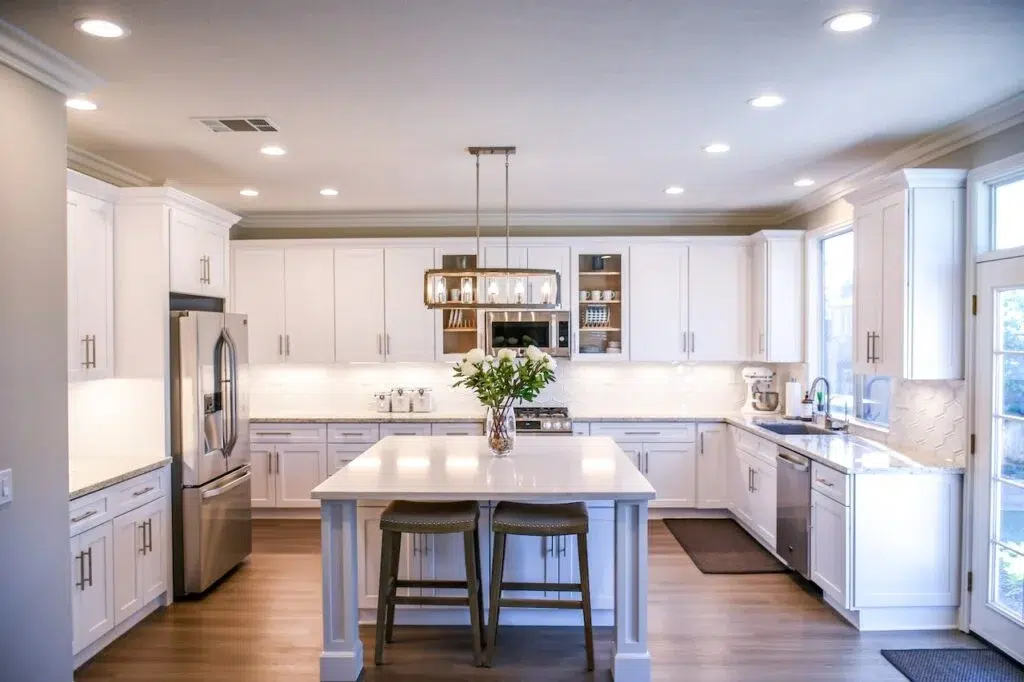
The layout is the foundation of any kitchen design, dictating the flow of movement and the overall functionality of the space. Popular layouts include U-shaped, L-shaped, and galley layouts, each offering unique advantages depending on the size and shape of the room. The U-shaped kitchen provides ample counter space and storage, making it ideal for those who spend a lot of time cooking. On the other hand, the L-shaped kitchen is versatile and can be adapted to various space sizes, while the galley kitchen is perfect for smaller spaces, ensuring everything is within easy reach.
Maximizing space and ensuring a smooth workflow is paramount, especially in busier households. Consider the ‘work triangle’ concept, which arranges the stove, sink, and refrigerator in a triangular layout to minimize unnecessary movement. Additionally, use vertical space with wall-mounted shelves and cabinets, and consider pull-out and corner cabinets to make the most of every inch of available space.
High-Quality Appliances
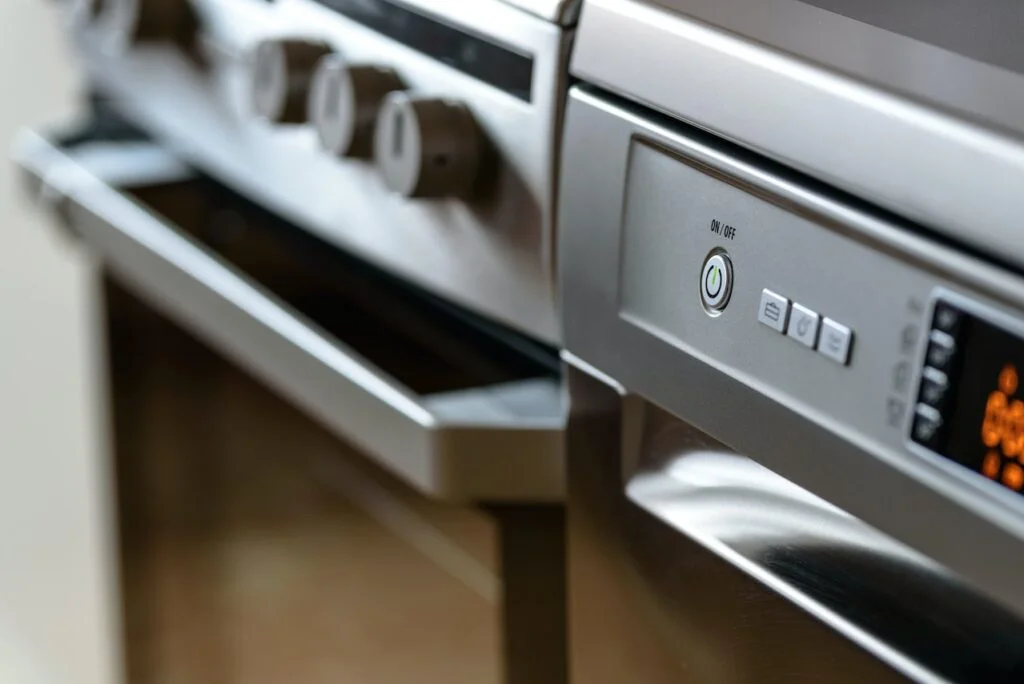
Appliances are the workhorses of an ideal kitchen, and investing in high-quality, reliable options is non-negotiable. Essential appliances include the refrigerator, stove, oven, dishwasher, and microwave. Opt for energy-efficient models to reduce utility bills and consider the size and capacity of each appliance to ensure they meet your needs.
Choosing reliable and efficient appliances ensures longevity and performance, reducing the need for frequent replacements and repairs. Look for reputable brands and check customer reviews to gauge the product’s reliability. Additionally, ensure the appliances match the aesthetic of your kitchen, creating a cohesive look.
Adequate Storage Solutions
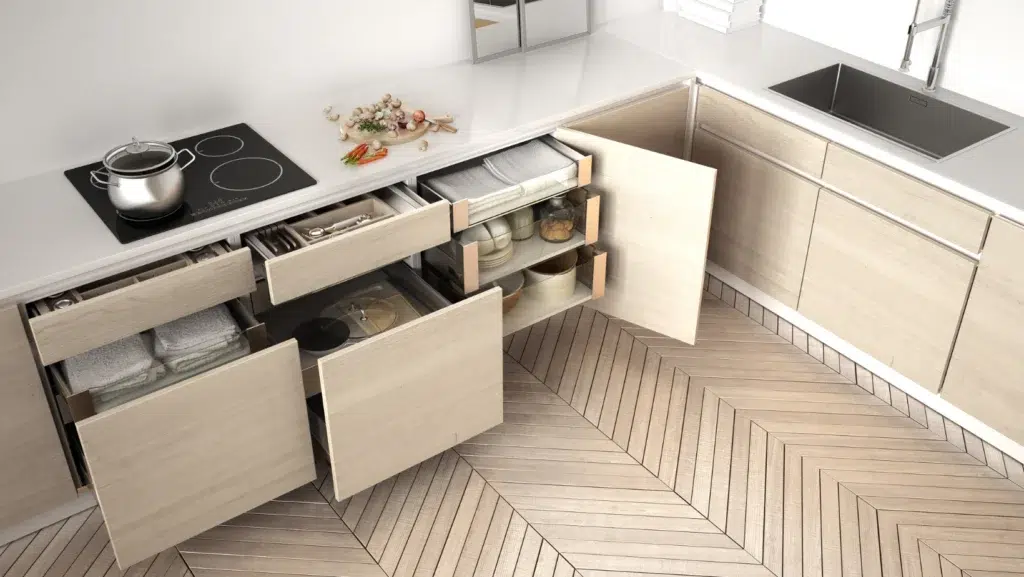
A clutter-free kitchen is a functional kitchen. Adequate storage solutions are crucial to keeping countertops clear and ensuring everything has its place. Invest in a combination of cabinets, drawers, and shelves to accommodate all your kitchen essentials. Consider innovative solutions such as pull-out pantry shelves, lazy Susans in corner cabinets, and built-in dividers for utensils and cookware.
Enough storage keeps the kitchen organized and ensures efficiency during cooking and preparation. It also contributes to the overall cleanliness of the space, making it a more enjoyable area to work in.
Durable and Easy-to-Clean Countertops
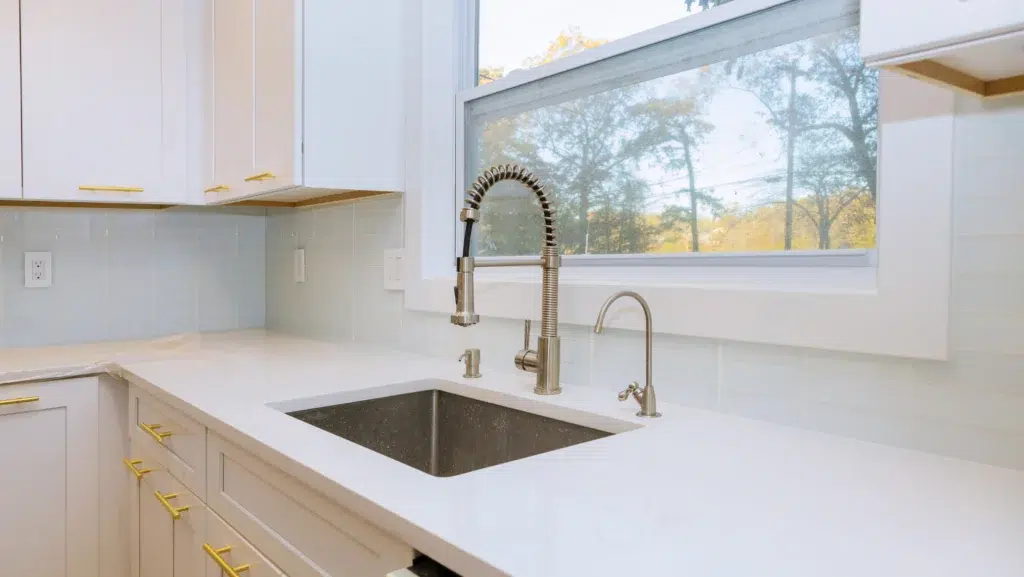
Countertops are one of the most used surfaces in the kitchen, and choosing a durable, easy-to-clean option is essential. Various material options are available, including granite, quartz, laminate, and stainless steel, each with its own advantages. Granites and quartz are popular for their durability and aesthetic appeal, while laminate offers a budget-friendly alternative with a wide range of design options.
Consider your cooking habits, maintenance preferences, and budget when choosing a countertop material. Opt for non-porous materials to prevent bacterial growth and stains, and ensure the countertop complements the kitchen’s overall design.
By paying careful attention to these essential components, you can create an ideal kitchen that balances functionality, style, and efficiency, ensuring it stands the test of time and enhances your daily living experience.
ALSO READ: Mastering the ABC of Soup Making: Essential Small Appliances and Gadgets for Every Mom
Lighting and Ventilation: The Unsung Heroes
When creating an ideal kitchen, lighting, and ventilation play pivotal yet often underestimated roles. These elements significantly contribute to the space’s functionality, safety, and ambiance, ensuring a comfortable and enjoyable cooking experience.
Importance of Good Lighting

Proper lighting is essential in a kitchen, not just for aesthetics, but for practicality and safety. Different kitchen zones require varied lighting solutions to accommodate their specific functions:
Task Lighting: Focuses on work areas such as countertops, sinks, and cooking surfaces. Under-cabinet and pendant lights are famous for providing bright, focused illumination.
Ambient Lighting: This creates a warm and inviting atmosphere, filling in shadows and making the space feel open. Ceiling-mounted fixtures and recessed lights are commonly used for ambient lighting.
Accent Lighting: Highlights specific areas or decorative elements within the kitchen, adding depth and interest to the design. This can include in-cabinet lighting or track lighting.
To create a well-lit and inviting kitchen space, incorporate a mix of these lighting types, ensuring each area is adequately illuminated. Use dimmer switches to control light intensity, and consider the color temperature of your bulbs — warmer hues create a cozy ambiance, while more fabulous shades are ideal for task lighting.
Ensuring Proper Ventilation
Good ventilation is crucial in maintaining a fresh and odor-free kitchen. Cooking activities produce smoke, steam, and odors, which can linger if not adequately ventilated, creating an unpleasant cooking environment and potentially leading to moisture-related issues.
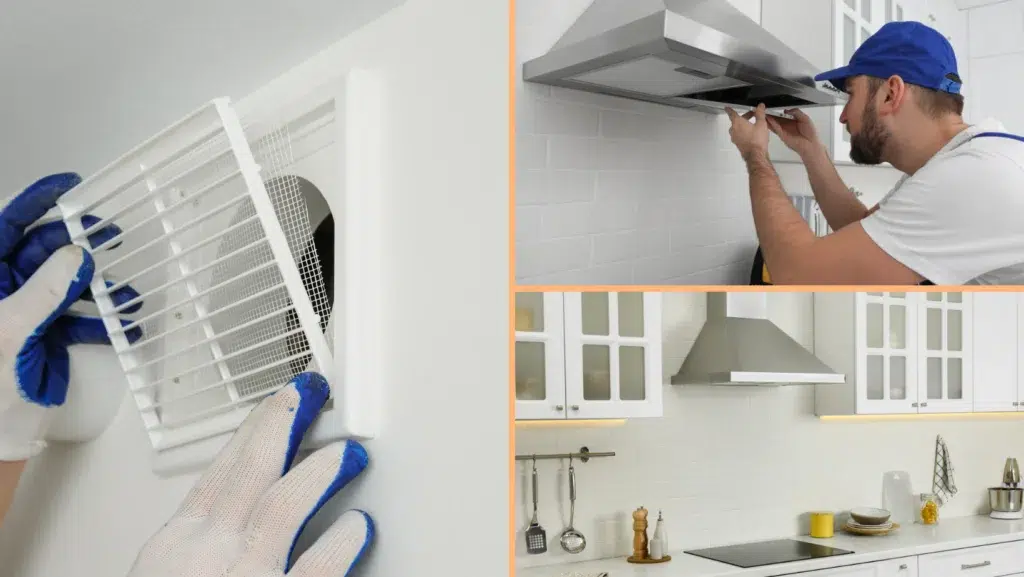
Range Hoods: The most common and effective ventilation option, range hoods remove airborne grease, smoke, and odors directly from the cooking area. Ensure your range hood is appropriately sized for your stove and kitchen space for optimal performance.
Exhaust Fans: Installed in the ceiling or walls, exhaust fans help circulate air, removing odors and moisture. They are particularly beneficial in kitchens without external windows.
Ventilated Ceiling Systems: For larger kitchens or commercial settings, ventilated ceiling systems provide powerful and even ventilation.
Natural Ventilation: Use windows and doors to allow fresh air to circulate, helping to clear odors and reduce humidity.
Investing in a quality ventilation system not only maintains a fresh and pleasant cooking environment but also contributes to the longevity of your kitchen by preventing moisture-related damage and ensuring indoor air quality.
By giving due attention to lighting and ventilation, you can significantly enhance your kitchen’s functionality and ambiance, creating a safe, comfortable, and enjoyable space. These unsung heroes play a vital role in the overall success of your kitchen design, ensuring it meets the standards of an ideal kitchen.
ALSO READ: A Beginner’s Guide to Flawless Outdoor Cooking: Avoid These Mistakes!
Personalizing Your Kitchen Space
Transforming a kitchen into a personalized sanctuary involves more than choosing functional elements; it’s about infusing the space with your unique style and preferences. Here’s how you can make your kitchen feel uniquely yours:
Choosing a Color Palette

The colors you choose for your kitchen are crucial in setting its mood and style.
Aesthetics: Opt for a color palette that complements the overall design of your home. Neutral tones can create a timeless and elegant look, while bold colors can add vibrancy and energy. Consider the color of your appliances, cabinets, and countertops to ensure a cohesive look.
Psychological Impact: Colors have the power to influence our emotions and behavior. Warm colors like reds and yellows can stimulate appetite and create a welcoming atmosphere, while cooler colors like blue and greens can create a calm and serene environment. Consider the mood you want to set in your kitchen when choosing your color palette.
Incorporating Personal Style
Personalizing your kitchen is about letting your personality shine through in the details.
Personal Touches: Displaying artwork, family photos, or cherished collectibles can instantly make the space more intimate. Consider open shelving or glass front cabinets to showcase your items.
Decor: Choose kitchen textiles, such as rugs, curtains, and dish towels, that reflect your style. Adding plants, or fresh flowers brings life and color to the space.
DIY Projects: If you’re crafty, consider DIY projects like painting your cabinets or creating your backsplash. This adds a personal touch and gives you a sense of accomplishment every time you step into your kitchen.
Innovative Kitchens: Embracing Technology
The integration of technology in the kitchen has brought about a revolution in how we cook, organize, and interact with our kitchen space. Here’s how you can embrace technology in your kitchen:
Innovative Kitchen Gadgets and Appliances
Smart kitchen devices are designed to make your cooking experience more efficient and enjoyable.
Smart Appliances: From refrigerators that can help you keep track of groceries to ovens you can control with your smartphone, smart appliances offer convenience and efficiency. Look for appliances connecting to the internet for updates and remote control.
Gadgets: Many smart kitchen gadgets are available, from Bluetooth thermometers that ensure your meat is cooked perfectly to smart timers that help you keep track of cooking times.
Functionality: Technology can greatly enhance the functionality of your kitchen, making it easier to cook, clean, and organize. Consider how each device will fit into your daily routine and choose products that make a difference in your cooking experience.
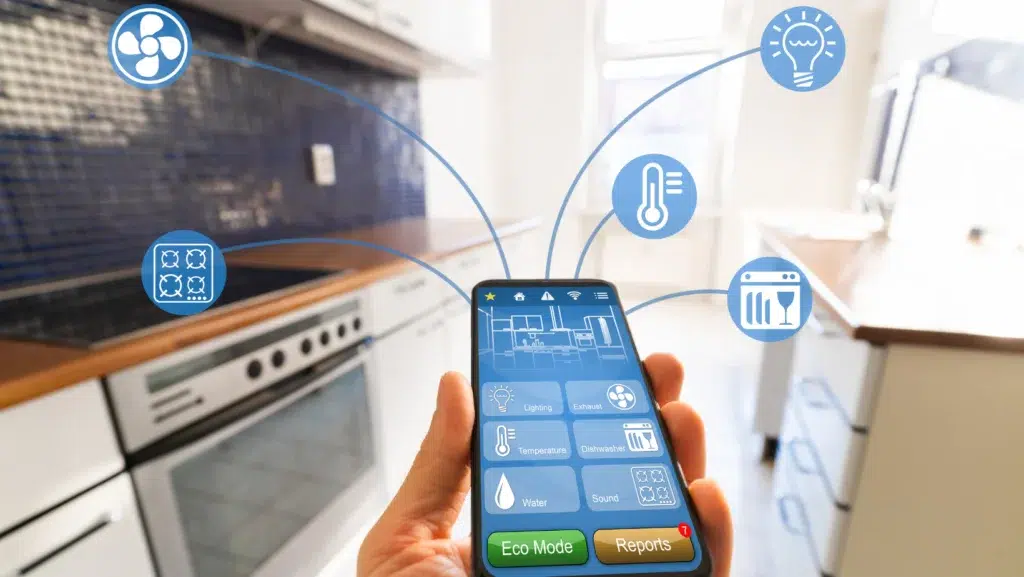
Energy Efficiency and Sustainability
Embracing technology also means considering the impact of your choices on the environment.
Energy-Efficient Appliances: Look for appliances with Energy Star ratings or other certifications that ensure they use less energy. This helps the environment and saves you money on your energy bills.
Sustainable Practices: Consider how you can use technology to reduce waste in your kitchen. This could include composting systems, smart bins that help you recycle, or apps that help you plan meals to reduce food waste.
Eco-Friendly Materials: When updating or renovating your kitchen, look for sustainable materials for countertops, cabinets, and flooring./.
Safety and Accessibility in the Kitchen
Ensuring that your kitchen is both safe and accessible is crucial for creating a space that’s welcoming and functional for everyone. Here’s how you can achieve that:
Designing a Safe Cooking Environment

Safety should always be a top priority in the kitchen, as it is a space filled with potential hazards, including sharp knives, hot surfaces, and electrical appliances.
Preventing Accidents:
- Store sharp knives in a knife block or on a magnetic strip.
- Keep heavy items at waist level to avoid heavy lifting.
- Ensure that your cooking zones are clutter-free.
Slip-resistant flooring can also contribute to a safer kitchen environment.
Safety Features: Consider safety features such as auto shut-off for your stove and oven, and ensure that your smoke detectors and fire extinguisher are in good working order and easily accessible.
Child-Proofing: If you have children, make sure to child-proof your kitchen by using safety latches on cabinets and drawers, keeping cleaning supplies and sharp objects out of reach, and ensuring that appliance cords are not dangling.
Creating an Accessible Kitchen
A truly ideal kitchen is accessible to everyone, regardless of age or ability.
Adjustable Workspaces: Consider adjustable countertops and wall units so individuals can access them in wheelchairs or of different heights.
Clearance Space: Ensure enough clearance space for wheelchair mobility, and opt for a loop or D-shaped handles on cabinets and drawers for easier grip.
Appliance Placement: Place appliances at accessible heights, and consider appliances with front controls for easier access.
Conclusion
Crafting the ideal kitchen is a fulfilling journey that combines functionality, style, and personal preference. We’ve delved into the key components that contribute to creating a kitchen space that is visually appealing, highly functional, and safe.
Recap of Key Components: An efficient layout ensures smooth workflow, while high-quality appliances enhance the cooking experience. Adequate storage solutions keep your space organized, and durable, easy-to-clean countertops contribute to the longevity and hygiene of your kitchen. Lighting and ventilation play critical roles in creating a comfortable atmosphere, and personalizing your space adds that unique touch that makes the kitchen truly yours. Integrating smart technology brings in a layer of efficiency and convenience, and prioritizing safety and accessibility ensures that your kitchen is welcoming and safe for everyone.
Encouraging Personal Design:
- When designing or renovating your kitchen, take the time to consider how each component fits into your daily life and personal style.
- Think about how you use your kitchen and what features are most important.
- Don’t be afraid to incorporate elements that reflect your personality, and remember that the best kitchen design suits your needs and lifestyle.
We’d love to hear from you! Share your kitchen design tips, success stories, or challenges in the comments below. Feel free to reach out if you need personalized advice or have specific questions. Your dream kitchen is within reach, and we’re here to help you make it a reality.
Frequently Asked Questions About Designing an Ideal Kitchen
This section is dedicated to answering some of the most common kitchen design and renovation questions, providing valuable insights to navigate your kitchen transformation journey.
What is the most efficient kitchen layout?
The efficiency of a kitchen layout depends on your space and needs. However, the U-shaped and L-shaped designs are famous for their functionality and ease of movement.
How do I choose the right appliances for my kitchen?
Consider your cooking habits, kitchen size, and budget. Look for energy-efficient appliances with good warranty and customer service reviews.
What are some innovative storage solutions for small kitchens?
Utilize vertical space with wall-mounted shelves, invest in multi-functional furniture, and consider pull-out cabinets to maximize space.
How important is lighting in the kitchen?
Lighting is crucial in the kitchen for safety, functionality, and aesthetics. Ensure you have a combination of task, ambient, and accent lighting to create a well-lit, inviting space.
What are some tips for creating a safe kitchen environment?
Keep the cooking zones clutter-free, store sharp objects safely, ensure proper ventilation, and consider slip-resistant flooring.
How can I make my kitchen more eco-friendly?
Choose energy-efficient appliances, implement recycling and composting systems, and opt for sustainable materials.
What are some ways to personalize my kitchen space?
Incorporate decorative elements that reflect your style, display personal collections, and choose colors and materials that make you feel at home.
How do I ensure my kitchen is accessible to everyone?
Consider adjustable countertops, ensure clear floor space for mobility, and choose hardware that is easy to grip.
What role does technology play in modern kitchens?
Smart technology in kitchens enhances functionality, convenience, and efficiency. From smart appliances to innovative gadgets, technology can transform your cooking experience.
How can I balance functionality and style in my kitchen design?
Focus on creating a layout that suits your cooking habits, choose durable materials, and add personal touches to marry functionality with style.

